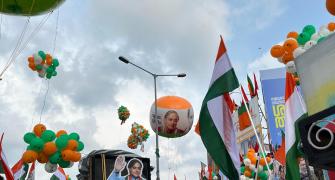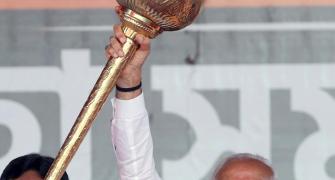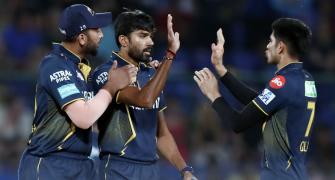When Sanjaya Malakar stood in a long queue for American Idol's audition on September 19, 2006, he had just one ambition: he wanted America to hear him. Keeping him company was Shyamali, his sister, who wanted her own spot of fame in the reality show. She didn't get past the initial rounds, but Malakar began his journey into the world of instant fame and recognition.
And even though American Idol still has some weeks to go before the winner is declared, the 17-year-old has already generated a 'Sanjaya epidemic' engulfing young girls and boys and the NRI tribe.
With websites spewing out extraordinary numbers of votes in his favour (some from a website called votefortheworst.com that encourages people to vote for the worst singer), it's clear that Malakar is on America's mind.
For someone who always wanted to be in the news, Malakar is news. And he's not alone in creating mass hysteria. Like him, a growing number of Indians in the West are gradually building their fan base, creating a cult following. Such as Sacha Jafri, for instance, who is being hailed as Britain's most important artist away from the "shock art" that has failed to survive its cult status of even Damien Hirst and Tracey Emin.
Fed up with eggs in formaldehyde and anything being passed off as alternate art, Britain has embraced this young artist with his old-fashioned use of canvas, brush and oil paint as a genius, turning up in hundreds when he paints live before huge audiences, seducing them with his energy and lyricism.
And yet, Jafri is not unaware of his Indian roots. "My dad reminds me that I am a direct line descendant of Prophet Mohammed, that my grandfather was a close friend of Gandhi and a pioneer both as an ambassador, diplomat, and a newspaper editor," he says -- one reason why "anything I achieve will not be a surprise to him".
Still, Jafri does not crave recognition the way Malakar does. "Ninety per cent of my brain is permanently filled with ideas for paintings, colours, marks, tones, sounds, lines. There is, therefore, not much space in my head for anything else," he says.
Or take Alpana Singh, a woman sommelier in a world that is not only rules-ridden, many of them pompous and old world, but also hopelessly male-dominated. In Chicago, Alpana Singh, a first-generation Indian American, is doing her bit to change that. Born to parents who migrated from Fiji and growing up in California, Singh didn't know a thing about wine, she confesses on her website.
The family were non-drinkers and Singh inititally aspired to a job in the US Air Force! When that didn't pan out, she applied for a job as a waitress at a local bistro with a great wine list. In the interview, she was apparently asked what she knew about wine and she said that it was made of grapes!
That was at 19. Six years later, she had taken that world by storm, having been inducted (at 26) to the Court of Master Sommeliers. She went on to be sommelier at Chicago's world-famous Everest restaurant for five years, before accepting an invitation to be director, wine and spirits, at the Lettuce chain of restaurants.
But brave wine recommendations apart, there's an obvious novelty factor to the sommelier herself that has landed her so many mentions in all genres of magazines, from Bon Appetit to Jane. What makes her so popular is that Singh, now a food show presenter and wine book writer, uses unconventional language!
Singh's quirky writing makes reading about the correct wine and food pairing more fun than it should be, with titles like "Wine Tasting Your Way to Mr Right", "Shoes You Never Wear and Wine You Never Drink", and "White Flight", about men's avoidance of white wines. It is not for nothing that Singh is the author of the 2006 book Alpana Pours: About Being a Woman, Loving Wine, and Having Great Relationships!
Recognition does count. For someone whose works hangs in the homes of the rich and famous - among them Jude Law, Prince Albert of Monaco, the Royal Families of Dubai and Sharjah, David Beckham, John McEnroe, Prince William and Bill Gates -- Sacha Jafri says he's humbled by their interest in him.
"Many are older collectors who have always collected art but usually less contemporary pieces. When these major collectors start taking an interest in your work, it is exciting," he confesses.
"I have a lot of American and European collectors who are between the ages of 30 and 40, who collect a lot of Pollock, Warhol, Gilbert and George, Damien Hirst, Lucien Freud, Liechenstein etc, and are now starting to collect my work -- this is obviously a pretty big compliment."
Then there's Kal Penn, fresh from his success in The Namesake, who has his personal page on a popular social networking site, MySpace.com. It is here that Penn, whose original name is Kalpen Suresh Modi, is creating fans from all over the world. Besides films, Penn will be a guest lecturer at the University of Pennsylvania to present two papers on Images of Asian Americans in the Media, and Contemporary American Teen Films.
Are we looking at a new trend? Are we staring at icons who are in their twenties and thirties and have alternate (as opposed to mainstream) professions? And what's prompting it? Penn, who according to The Namesake director Mira Nair, "looked goofy, charming, comic when he first stepped into the studio", feels that even though Indians and other minorities have not yet broken out of their stereotypes in mainstream Hollywood, things are looking optimistic.
Tanuj Chopra, a young film director who made Punching at the Sun, a film about a young Indian NRI who is tormented by his brother's sudden death in a convenience store, and won prestigious awards at Tribeca, Sundance and San Francisco International Asian American festivals, says, "A majority of Indians in the West never really encouraged its members to break into creative fields. Today that's changing as directors and writers from South Asian communities are portraying realistic stories."
Penn, who still sends all his scripts to his mother, says till recently Indians in Hollywood were given just two-line scripts as "convenience store owners and doctors".
Thankfully television is bringing in a new wave with actors like Parminder Nagra (of Bend it like Beckham fame), Sendhil Ramamurthy and Maulik Pancholy, who star in E.R., Heroes and 30 Rock respectively.
And on television it's hard to ignore Naveen Andrews, best known for his role as Sayid in the hit television series Lost. Originally from Kerala, Naveen William Sidney Andrews' parents migrated to London after their marriage and he pursued his interest in creative arts in London's Guildhall School of Music and Drama.
A recovering drug addict and alcoholic, Andrews' latest performance includes Provoked. His forthcoming projects include Grindhouse and the third season of Lost.
While Andrews is balancing his career in films and television, Penn is still gathering accolades for his performance as Gogol in The Namesake. And if in reel life Kal Penn struggled with his name Gogol, in real life Penn admits to having changed his name to get more auditions for roles in the West.
He says this small change upped his auditions to studios by 50 per cent. But he does try to include his real name (Kalpen Modi) in the projects he does. In The Namesake, he's given two credits -- as Penn (for Gogol) and as Kalpen (for his screen performance in the same film as Nikhil).
In Harold and Kumar Go to White Castle too, Penn is credited as Modi in his capacity as production assistant. Born to Gujarati parents, he grabbed the role of Gogol in The Namesake thanks to Nair's son who forced his mother to "check out the Kumar guy". What followed was a passionate letter written by Penn to Nair begging her for the role.
Penn graduated from the University of California with double majors in film and sociology. A vegetarian by birth, he downed soy burgers in the name of beef burgers and smoked some herbs that eventually became pot smoke in Harold and Kumar. His popularity forced the crew of The Namesake to postpone the shoot by a few hours, when a group of boys and girls began shouting 'Kumar' on a New York street where the film's shooting was in progress.
Jafri too, inspired by India's "rich colours and energy.smells and sounds", says he became a "performance artist" as a reaction against "shock art, fast art or lazy art; anything that aims to shock people into a disgusted, scared or disturbed reaction is not something to which I would ever aspire.
I am aiming to slow art down, slow the viewer down and encourage them to have their own private experience and ultimately a unique relationship with my paintings. I want to bring the painter back to the forefront of the art world, stay away from modern technology and merely aim to inspire the viewer. And in order to make more people aware of the painter.it helps if I can paint live. Paintings are not just about the finished product but are also about the process and the passion that goes into making each piece of work."
Jafri has painted live in front of a 5,000-strong audience in The Royal Albert Hall as well as in Dubai, Singapore, New York and Monaco.
If creative icons are new role models who have helped global Indians look beyond just Sabeer Bhatia and Vikram Chatwal, then Anand Chhatpar makes the cut for not just being part of the new fold but also exhibiting a strong entrepreneurial streak. For most rich kids who pay their way through university abroad, graduate school is usually about partying than anything else.
For Mumbai-based Chhatpar, however, his sojourn at the University of Wisconsin turned out to be very different. While in his second year there, in 2004, he founded BrainReactions, a company offering corporate solutions to high-profile clients like Bank of America, Intuit, Procter and Gamble and the UN by tapping the huge talent pool of Ivy League students.
This startlingly simple piece of entrepreneurship won him huge, undisclosed sums of money and also mentions in magazines such as Businessweek, which voted him one of the top under-25 entrepreneurs in the US.
Chhatpar's entire operation revolves around hundreds of college students, the best and the brightest in their fields, brought under a common umbrella to brainstorm on any particular problem that a company presents BrainReactions with. Chhatpar says the effort is to mix as many different backgrounds and talents as possible and each session can generate up to 500 ideas, from the workable to the wacky.
At the end of the session, clients are referred to a password-protected website where the ideas are stored and the most promising ones analysed. In effect, this is a win-win situation. For the company, skilled labour is made available at a fraction of the cost (all students work part-time for $20 per hour and benefits like free pizza). For the students, it means interacting with the biggies and potential recruitments once they finish school.
If you were to trace the roots of Chhatpar's enterprise, you would have to go back to when he finished class 10 in Mumbai and decided to do a diploma in computer engineering from a government polytechnic.
Born into a business family, the bright, rich boy saw a "very different side of life. I learnt to do hard work with my hands as I learnt things like carpentry, welding, plumbing and smithy along with the basics of technology and engineering". He commuted in local trains and spent hours in the canteen with friends who were used to studying under the street lights because they did not have an electric connection in their house.
Chhatpar is back in India -- his company is training top executives from several companies on "innovation technique"; people including Venky Rao of Satyam, Pratap Mungi, convenor CII Maharashtra State Council, and others.
He is bashful about whether young Indian students consider him a role model. Richard Branson, should be one, he says -- this despite his profile appearing as a case study in the latest edition of Entrepreneurship: Successfully Launching New Ventures by Dr Bruce Barringer, which is an MBA textbook in over 120 US universities.
Global recognition against odds is something Malakar might face now as he rakes in all the attention at American Idol. And while threats such as judge Simon Cowell saying he'll quit the show if "ponyhawk" Malakar wins is old news, what's new is fast-food restaurant chain KFC reportedly offering him $5,000 to wear a bowl-cut on the show. Wanting to promote its chicken combinations served in special bowls, KFC want Malakar to appear in a commercial for the product.
According to Pete Blackshaw, chief marketing officer, Nielsen BuzzMetrics, "Sanjaya has quickly become a pop-culture phenomenon and is significantly influencing the volume, tenor and tone of conversation around American Idol." He adds, "Our buzz analysis wan-ted to help solve the riddle of viewer engagement and fan fanaticism for Sanjaya."
For now this fanaticism is more than welcome. But do they see themselves as role models for young Indians? "Me?" asks an astonished Jafri. "Sachin Tendulkar, yes, but Sacha Jafri, no. Ha ha!" Oh, well.
Inputs: Anoothi Vishal & Kishore Singh








